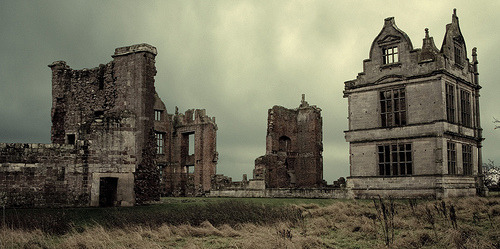'For there is good news yet to hear and fine things to be seen,
Before we go to Paradise by way of Kensal Green.'
'The Rolling English Road' (1913) G. K. Chesterton
The spectacular monuments at Kensal Green Cemetery.
Imagine London, 1830s. The population has more than doubled from around 1 million in 1799 to approximately 2.34 million. There have been, and are to come, medical epidemics in which thousands of people die. In 1832, Cholera came to London. Medicine was primitive at best and most people feared going to a hospital as they knew if they died, their bodies could be used for dissection (the 1832 Anatomy Act had not yet come into fruition). The disease naturally spread; sanitation was poor at best. It became clear that an area for the burial of dead, away from the over-crowded graveyards of local parish churches, was desperately needed.
In response to this, there was an Act of Parliament passed on July 11 1832 that established a 'General Cemetery for the Internment of the Dead in the Neighbourhood of the Metropolis'. The General Cemetery Company (who had formed in 1830) bought land in West London, thus paving the way for the General Cemetery of All Souls, Kensal Green, the first of London's Magnificent Seven garden-cemeteries. The cemetery was consecrated on January 24 1833 by the Bishop of London and its first burial took place seven days later.
Mausolea just adjacent to the Anglican Chapel
“The ground is laid out in gravelled roads of sufficient width for carriages, and planted with forest trees, evergreens, and other shrubs and flowers. The visitor has before him a long vista of slightly-ascending ground, termination of which is concealed by trees and shrubs”( August 1834).
A solitary tomb inside the extensive colonnades that cover the catacombs.
Kensal Green Cemetery is the stereotypical Victorian cemetery. There are elaborate funerary monuments which bear the recognisable motifs of death and eternal life. Many of the free-standing mausolea are listed buildings themselves, including that of HRH Prince Augustus Frederick, Duke of Sussex (1773-1843) and Princess Sophia (1777-1848).
Princess Sophia's marble sarcophagus
Princess Sophia's magnificent memorial is a marble sarcophagus and tomb chest on a granite podium designed by Ludwig Gruner of Dresden. This was a wonder to see but there was another memorial that makes Princess Sophia's monument look boring in comparison: Andrew Ducrow's flamboyant Eygyptian-style tomb.
The Ducrow Memorial
I did not realise the grandeur of this memorial until I stood in front of it. At the time of its completion, it was described as a, 'ponderous coxcombry' by a contemporary. I get the feeling that Ducrow was proud of this extreme show of exhibitionism as the tomb bears the inscription, 'THIS TOMB IS ERECTED BY GENIUS FOR THE RECEPTION OF ITS OWN REMAINS.' Need I say any more?
Ivy upon a tomb at Kensal Green Cemetery
Notable Burials
- Marc Isambard Brunel (1769-1849) - civil engineer who constructed the first Thames tunnel at Rotherhithe.
- Isambard Kingdom Brunel (1806-1859) - one of the greatest figures of the industrial revolution who built the Great Western Railway and designed the Clifton Suspension Bridge.
- Charles Babbage (1791-1871) - the 'father of modern computing'.
- Lady Anne Isabella Byron (1792-1860) - poet and wife of Lord Byron.
- The Duke of Sussex (1773-1843) - the third son of George III.
- Princess Sophia (1777-1848) - a daughter of George III.
- The Duke of Cambridge (1819-1904) - grandson of George III.
The grave of the famous Brunel engineering family
My Dark Travels Rating: 9/10
I spent approximately 3 hours wandering around the cemetery, looking at the numerous graves, tombs and mauseolea. Kensal Green Cemetery is huge, you will need to dedicate an afternoon meandering through the glorious paths of the dead. Highlights include the Ducrow memorial, the Anglican Chapel and the Pere Lachaise-style tombs that line the Chapel's west avenue. I really enjoyed Kensal Green Cemetery because it was steeped in history and beautiful architecture. I have awarded it a 9/10 rating because, after all, Kensal Green was the first of the London Cemeteries and it set a high standard indeed.
Kensal Green Cemetery is free to visit if you wish to wander around unguided. There was a helpful volunteer who gave me a useful map of the cemetery when I asked - I would recommend this because it is huge! It took around 20 minutes of aimless wandering before I found Isambard Kingdom Brunel's grave! The Friends of Kensal Green Cemetery offer guided tours of the cemetery every Sunday afternoon from the beginning of March to the end of October,and the first and third Sunday of the month in November, December, January and February. They are at 2pm and there is a suggested donation of £7.
I drove and parked on a nearby residential street - do watch out for restrictions though. You can drive through the cemetery but it was much more magical to wander in on foot. The nearest tube station is Kensal Green Station on the Bakerloo Line. The bus stop is 'Stop W' and the number 18 (to Euston) bus runs here.
Kensal Green Cemetery, London.
A draped urn memorial. The urn symbolises a vessel for the soul and ashes of the dead. The draped fabric is also a popular Victorian symbol of mourning.
The tomb of the Paul family. It is a Grade II listed doric temple.
Kensington Gas Works as seen from the cemetery
The entrance to the vaults, 1864.


































